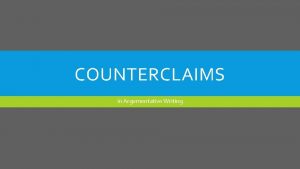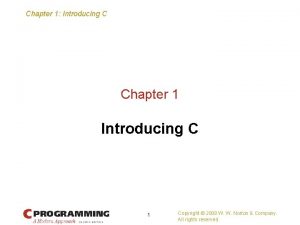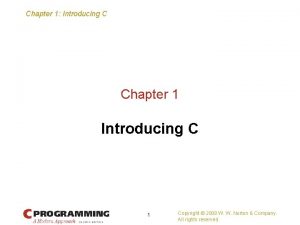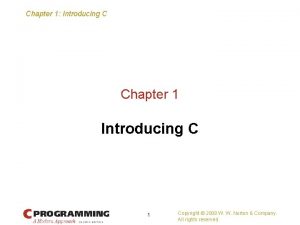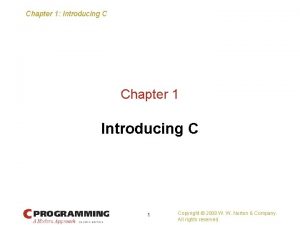Chapter 1 Introducing C Chapter 1 Introducing C







- Slides: 7

Chapter 1: Introducing C Chapter 1 Introducing C 1 Copyright © 2008 W. W. Norton & Company. All rights reserved.

Chapter 1: Introducing C Properties of C C is an imperative computer programming language. • Low-level – It is based on program statements to describe the operations in details. • Small – Compiler and library codes take little memory space. • Permissive (allows all kinds of low level coding) – Flexibility is a disadvantage as well as an advantage. – It may not warn you if you make mistakes in coding, assuming that you made it on purpose. 2 Copyright © 2008 W. W. Norton & Company. All rights reserved.

Chapter 1: Introducing C Origins of C • C is a by-product of UNIX, developed at Bell Laboratories by Ken Thompson, Dennis Ritchie, and others. • The language was stable enough by 1973 that UNIX could be rewritten in C. 3 Copyright © 2008 W. W. Norton & Company. All rights reserved.

Chapter 1: Introducing C Standardization of C • K&R C – Described in Kernighan and Ritchie, The C Programming Language (1978) – De facto standard • C 89/C 90 – ANSI standard X 3. 159 -1989 (completed in 1988; formally approved in December 1989) – International standard ISO/IEC 9899: 1990 • C 99 – International standard ISO/IEC 9899: 1999 – Incorporates changes from Amendment 1 (1995) 4 Copyright © 2008 W. W. Norton & Company. All rights reserved.

Chapter 1: Introducing C C-Based Languages • C++ includes all the features of C, but adds classes and other features to support object-oriented programming. • Java is based on C++ and therefore inherits many C features. • C# is a more recent language derived from C++ and Java. • Perl has adopted many of the features of C. 5 Copyright © 2008 W. W. Norton & Company. All rights reserved.

Chapter 1: Introducing C • • • Strengths of C Weaknesses of C Efficiency Portability Power Flexibility Standard library Integration with UNIX • Programs can be errorprone. (Open to errors) • Programs can be difficult to understand. • Programs can be difficult to modify. 6 Copyright © 2008 W. W. Norton & Company. All rights reserved.

Chapter 1: Introducing C Effective Use of C • Learn how to avoid pitfalls. • Use software tools (lint, debuggers) to make programs more reliable. • Take advantage of existing code libraries. • Adopt a sensible set of coding conventions. • Avoid “tricks” and overly complex code. • Stick to the standard. 7 Copyright © 2008 W. W. Norton & Company. All rights reserved.






